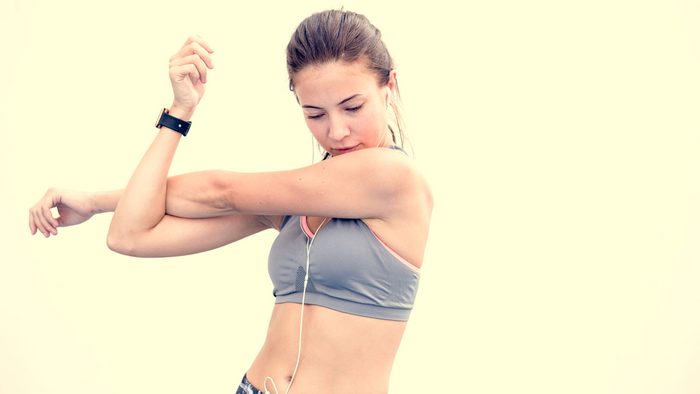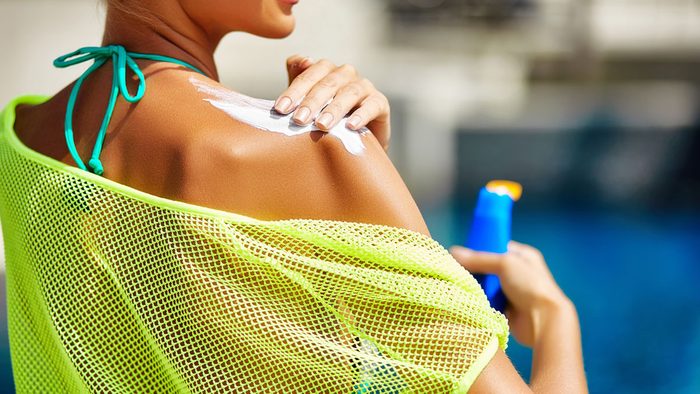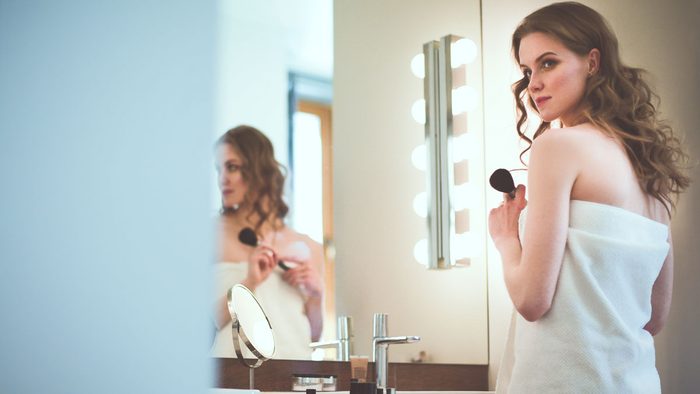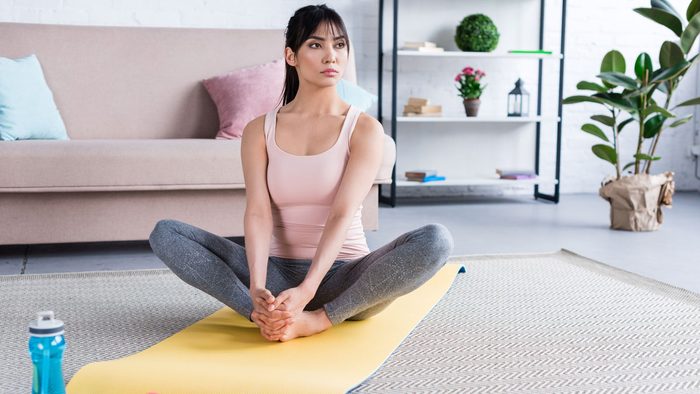
Embrace exercise
Exercise can help create a firm foundation for your breasts. Lisa Workman, a CSEP-certified exercise physiologist in Edmonton, says that push-ups and the plank will activate chest muscles. Workman recommends that beginners try one set of 12 to 15 push-ups, while seasoned exercisers can do up to three sets. For the plank, hold the position for at least 30 seconds.
Targeting your upper back muscles will also help. “Strengthening the upper back can pull the shoulders back and lift the breasts,” says Workman. A seated or standing row using a pulley system at the gym, or tubing anchored on a door at home can do the trick. No equipment? Squeeze the shoulder blades together and drop them down for 20 to 30 seconds.
Working out regularly can also cut your breast cancer risk. A French study published in the Cancer Epidemiology, Biomarkers and Prevention journal in August 2014 found that women who exercised routinely for four years had a 10 percent lower risk of developing breast cancer than their inactive counterparts. “For that benefit, do 150 minutes of moderate intensity activity (such as biking, swimming, jogging, walking) every week,” says Workman. Want to get active? This is the best workout for your age.

Practice skin smarts
The delicate skin of your décolletage and breasts requires TLC. Dr. Lisa Kellett, a dermatologist at DLK on Avenue in Toronto, says there’s a trick to boost your chest moisturizing routine. “Apply a gel or cream moisturizer after a bath when your skin is wet to increase its absorption,” she says.
Sunscreen should also be applied daily regardless of the season. A plunging v-neck top can leave your breasts exposed to harmful rays. “Use an SPF of 30 or higher and look for both UVA and UVB blockers listed on the packaging,” says Kellett. Get into the year-round SPF habit by applying sunscreen after your moisturizer. Are you missing these common areas when you apply sunscreen?

Get a history lesson
Talk to your mom and grandmother about their medical history so you can be more proactive about your own health. Dr. Jane Philpott, chief of the department of family medicine at Markham Stouffville Hospital and an assistant professor at the University of Toronto, recommends asking about breast cancer as well as ovarian cancer since the two are often linked in families. It’s also important to find out if these cancers happened at a young age – breast and ovarian cancers occurring before the age of 50 could have a genetic cause. “If you have a family history of certain cancers, your doctor might recommend that you have genetic testing,” she says. This is what one woman wishes she had known before getting a breast reduction.

Treat chest acne carefully
It’s not uncommon for adult women to experience acne breakouts on the chest. “Don’t pick or squeeze chest breakouts because the skin is prone to scaring and cyst formation,” says Kellett. A five percent benzoyl peroxide product can help heal pimples, but if the breakouts are cyst-like, see a dermatologist. Without proper care, cystic acne can create keloid (dense fibrous tissue) scars. These are the anti-aging treatments doctors actually use.

Be breast aware
Know the bumps and appearance of your breasts so that you can spot any changes that could signal cancer. “Women need to know what their normal feels like,” says Philpott. If you find something that isn’t normal, see your physician and have it investigated. Once you reach age 50, your physician will recommend mammogram screening every two to three years.
It’s also important to know that some breast cancers can leave clues on the skin. Kellett warns that Paget’s disease is often missed because it can look like a patch of eczema. “Paget’s disease is a type of breast cancer that can look like flakey skin on, or around the nipple,” she says. If you find dry, scaly patches around the nipple that don’t clear up after a week, Kellett recommends making an appointment with a dermatologist for a proper diagnosis.
Don’t forget to schedule a regular gynecologist appointment, too. This is what your gynecologist secretly wishes they could tell you.

Watch your posture
Poor posture can make your breasts look droopy. “The more stooped forward you are, the less complimentary it is to your breasts,” says Workman. While standing, visualize a straight line traveling through your spine. Your ears should be stacked over your shoulders, your shoulders over your hips and your knees slightly bent. When seated, pull your shoulder blades back and down to eliminate rounded shoulders, uncross your legs and rest your feet flat on the floor. These fitness myths could do serious damage to your health.

Breastfeeding helps
Studies have found that breastfeeding can lower breast cancer risk. “We’re not clear why, but there’s one theory that during breastfeeding you have fewer menstrual cycles, so there’s less of an estrogen effect on the breasts,” says Philpott. Research also suggests that breastfeeding for nine months or longer has more of a positive effect than breastfeeding for just a few weeks. Missed your period? One of these sneaky reasons could be why.
